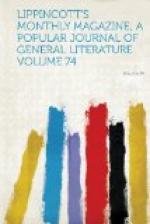Each flag represents a number, and four flags can
be hoisted at once on the staff. With the flags
there is given a book containing the meaning of each
number. Thus, a wrecked ship cries silently to
the shore, “Send a lifeboat” by flags 3,
8, 9, or says that she is sinking by 6, 3, 2; or a
vessel under full sail hails another by 8, 6, 0, or
bids her “
bon voyage” with 8, 9,
7. Owing to the difficulty of distinguishing
colors in cloudy days or when the flags will not fly,
other systems of signaling are used: that of
cones similar to umbrellas being considered in the
English service one of the most efficient, a different
arrangement of cones on the staff representing the
nine numerals. Men may convert themselves into
cones in an emergency by raising or letting fall their
arms, and two men thus give any signal necessary.
As the flags, however, belong more especially to Sergeant
G—— ’s duty on the field of
battle or to exceptional cases of storm and danger,
we pass them by to examine into his daily round of
duty. Outside, a queer little house of lattice-work
perched on a headland shelters the thermometers and
barometers: on a still higher point directly
over the foaming breakers is the anemometer, the little
instrument which measures the swiftness of the fiercest
cyclone as easily as the lightest spring breeze.
It consists of four brass cups shaped to catch the
wind, and attached to the ends of two horizontal iron
rods, which cross each other and are supported in
the middle by a long pole on which they turn freely.
The cups revolve with just one-third of the wind’s
velocity, and make five hundred revolutions whilst
a mile of wind passes over them. A register of
these revolutions is made by machinery similar to a
gas-meter. The popular idea, by the way, of the
speed of the wind runs very far beyond the truth:
we are apt to say of a racer that he goes like the
wind, when the fact is the horse of a good strain of
blood leaves the laggard tempest far behind; the ordinary
winds of every day travel only five miles an hour,
a breeze of sixteen and a quarter miles an hour being
strong enough to cause great discomfort in town or
field: thirty-three miles is dangerous at sea,
and sixty-five miles a violent hurricane, sweeping
all before it.
Our friend the sergeant examines seven times a day
at stated periods the condition of the atmosphere
as to heat, weight and moisture, the velocity of the
wind, the kind, amount and speed of the clouds, and
measures the rainfall and the ocean swell: all
these observations are recorded, and three are daily
reported to headquarters at Washington. In these
telegrams a cipher is used—as much, we presume,
to ensure accuracy in the figures as for purposes
of secresy. In this cipher the fickle winds are
given the names of women with a covert sarcasm quite
out of place in the respectable old weather-prophet
whom every housewife consults before the day’s
work begins. Thus, when the telegraph operator
receives the mysterious message, “Francisco Emily
alone barge churning did frosty guarding hungry,”
how is he to know that it means “San Francisco
Evening. Rep. Barom. 29.40, Ther. 61, Humidity
18 per cent., Velocity of wind 41 miles per hour, 840
pounds pressure, Cirro-stratus. N.W. 1/4 to 2/4,
Cumulo-stratus East, Rainfall 2.80 inch.”?




